Last Updated: 04/11/24
Applies to:
Migration Wizard users that have existing data in their target portals and need to match records to avoid data duplication.
Solutions Overview:
Explanation of the steps required for the proper matching process before the migration.
Tactical Rundown:
There often happen situations when the destination CRM is actively used and already contains some dataset, and either part or all of the records of certain objects from the source CRM already exist in the target CRM. If you would like to avoid data duplication, and just migrate records that you are missing, we offer a matching feature in our migration wizard.
Let's say you earlier imported companies to your target CRM in an alternative way - sync or native import, and preserved the ID from the source in a custom field. If you want to avoid bringing them over again during the migration process, and just wish to bring over records related to them - contacts, deals, activities (or only some of those), at the Entities step you still need to select the companies' object in the migration wizard.
The matching functionality includes the following key capabilities:
Refresh
Users can initiate a "Refresh" action, which updates the matching to reflect the latest data records. .png?width=688&height=164&name=DATATOCRM-18094-refresh-button%20(1).png)
When the Refresh button is clicked:
- The current matching data is preserved, and any new records are added to the existing matching.
- The Refresh popup displays the matching rules that were applied to the current matching version. These rules cannot be changed, as the refresh process relies on the active rules.
- The "Refresh cached data" button has been updated to allow separate settings for the source and target objects. By default, the caches for both objects will be rebuilt during the matching process. Users can customize this by clicking the "customize" button to disable the rebuild for either the source or target.


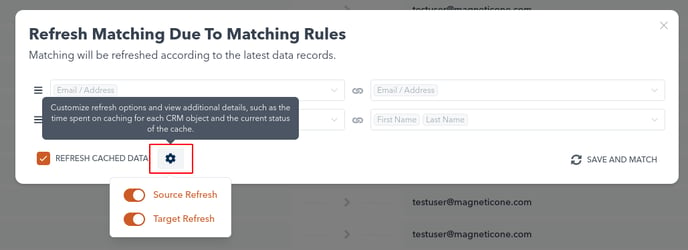
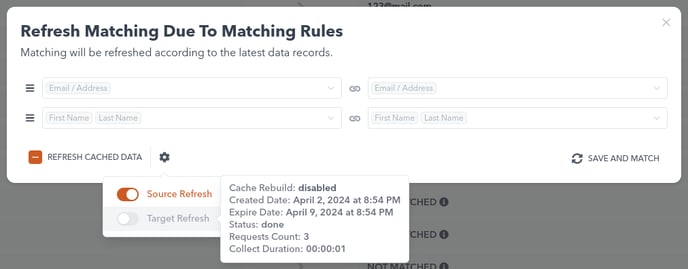
- The Refresh process includes an additional sub-process to handle version changes, comparing the active and new matching versions to identify differences.
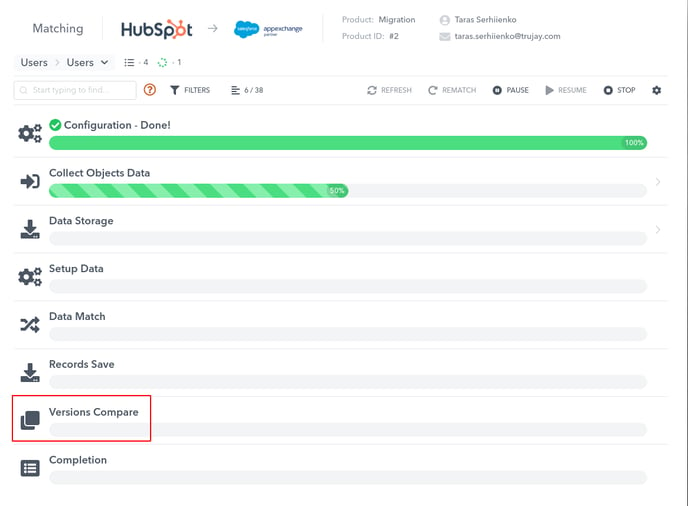
- After the Refresh, matched records from the previous matching version remain unchanged. New records created on the source/target CRM object since the last match are marked with a "new" tag. Records deleted on the target CRM object or filtered by the migration filter are marked with a "not in target" tag.
.png?width=655&height=267&name=DATATOCRM-18094-record-new%20(1).png)
.png?width=655&height=159&name=DATATOCRM-18094-record-not-exist%20(1).png)

Filters
The matching functionality includes the ability to filter matching records based on their status. Users can filter records that have "new" and "not in target" statuses..png?width=688&height=234&name=DATATOCRM-18094-record-filters%20(1).png)
Records Summary
A new button has been added to provide a summary of the matching records:
- The button displays the number of "matched" records compared to all ("source") records.

- Additional details can be accessed by clicking the button.
.png?width=655&height=415&name=DATATOCRM-18094-summary%20(1).png)
USE CASES
Below you will find two possible scenarios of using records matching in our tool:
If you are sure that all companies from the source CRM exist in the target CRM under the matching IDs, you just need to enable matching and disable migration for the companies object:

When you're ready, click "Next" to proceed.
When accessing the next page (the Wizard Matching step), you will see all entities that require matching. To begin the matching process, matching rules need to be established.
Entities that require rule definition will be flagged for your attention.
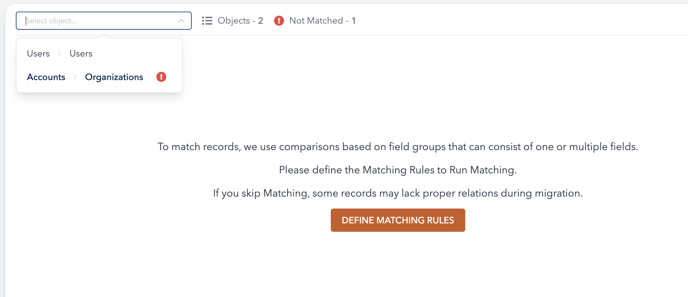
As you progress through the matching, we'll also provide you with information about the count of records and the matching status.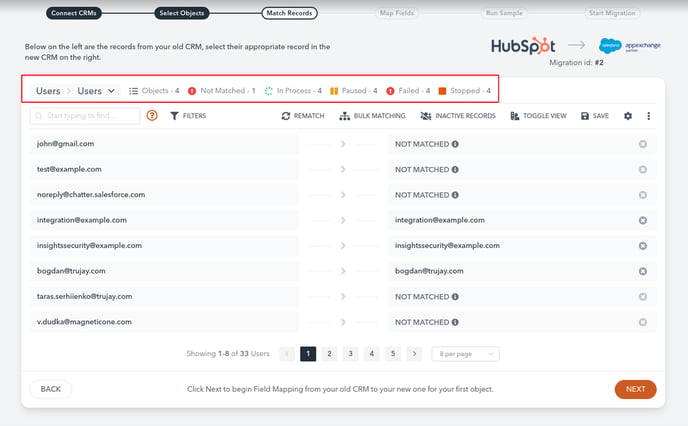
To begin the matching process, you'll click on 'Define Matching Rules", then select the fields to use for matching for each object: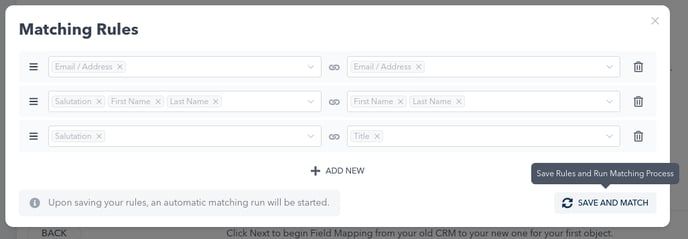
Each matching rule will function with an 'OR' operator, whereas the fields within each row will function as 'AND'. Up to five fields per system can be selected within each rule.
Please note: Complex fields (often shown with a '/', such as 'Email/Address' in the image above) include pointers to other fields. If you are choosing to match a complex field, make sure to click into it and select the specific field you'd like to match.
.png?width=688&height=296&name=DATATOCRM-17518-match-rules-complex-explanation%20(1).png)
2. If you are unsure and you'd like to bring over all the missing companies, you can enable both matching and migration features for this object: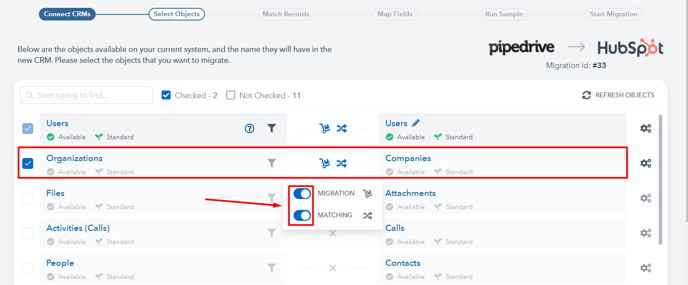
Match records according to your needs, by selecting options from the drop-down menu. Click the "Next" button:
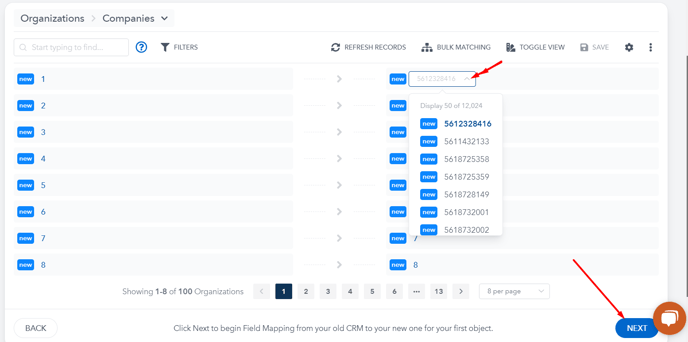
After clicking the "Next" button, you will be directed to the mapping page: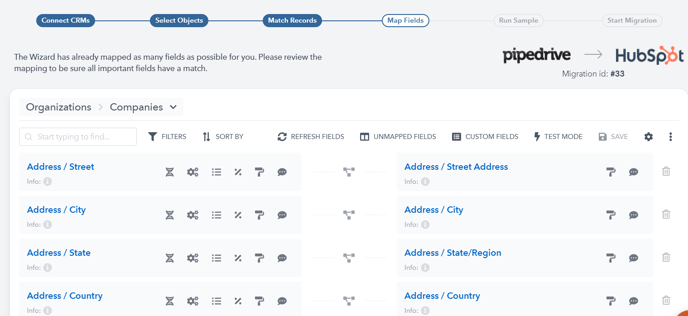
Once you ensure that everything looks correct, you can then proceed with the sample and full migration!
Still Need Help?
Please submit an inquiry on the contact page or email support@syncmatters.com.